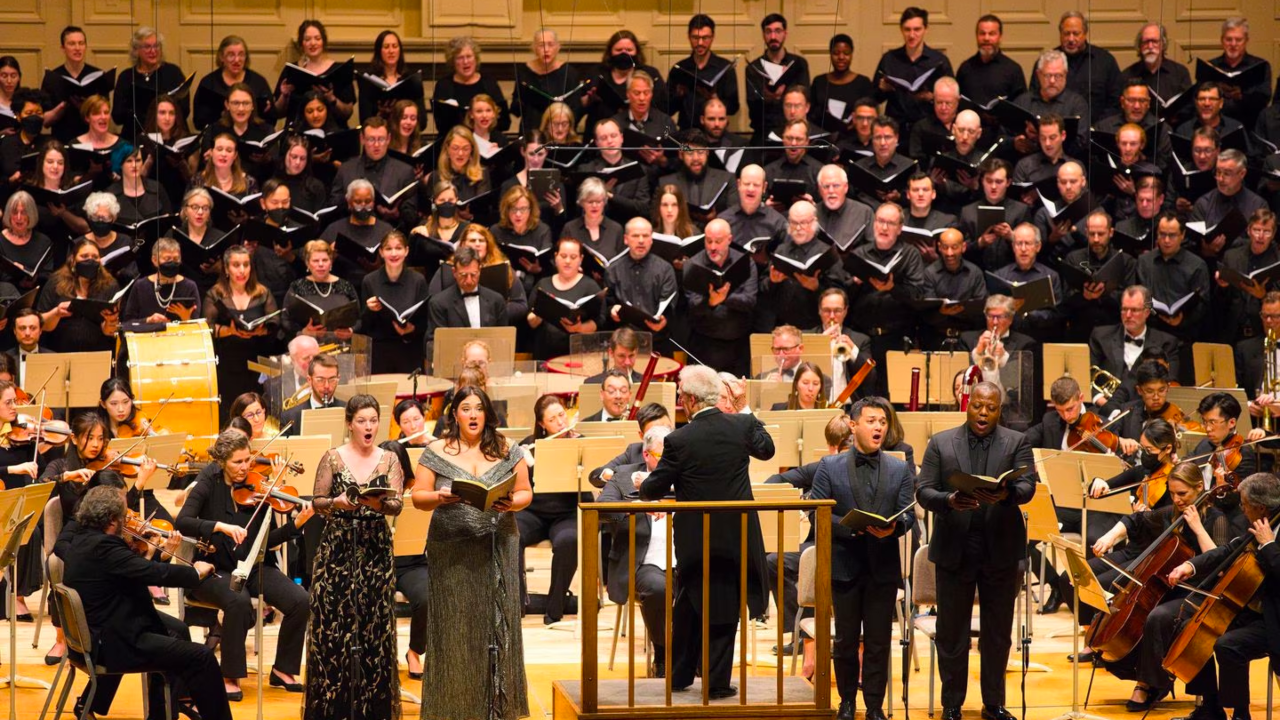Benjamin Zander and the Boston Philharmonic do it Beethoven’s way at Symphony Hall

In 1815, Johann Nepomuk Mälzel patented a metronome, and Ludwig van Beethoven embraced the new instrument as a way of letting performers know what tempos they should take for his music. He wrote down metronome marks for many of his works, including all nine symphonies. Over the past 200 years, musicians have tended to ignore those tempo indications — particularly those for the Ninth Symphony. For 40 years, however, Benjamin Zander and the Boston Philharmonic Orchestra have been attempting to take Beethoven at his word in performances of the Ninth. Friday in a sold-out concert at Symphony Hall, Zander and the BPO reminded us that the real Beethoven was a revolutionary.
There is, of course, more to “authentic” Beethoven than tempo. The BPO doesn’t perform on period instruments, and its first and second violins are not antiphonally deployed, as they would have been in Beethoven’s day. What’s more, the tempo a composer hears in his head tends to be faster than what works in practice. And we don’t know for sure that all of Beethoven’s metronome marks are accurate to his intentions. What we do know is that tempo was extremely important to him. Many of his metronome marks for the Ninth are thought to be implausible, but we can’t assess them until we hear them, and Zander is one of the very few conductors who has let us hear them.
Beethoven opens the Ninth with a thunderbolt, and in Friday’s performance it zipped across the sky. Zander backed off slightly from Beethoven’s bracing 44 measures to the minute to let that first theme breathe; then his judicious rubato gave the knotty second subject group an air of calm amid the storm. Still, this first movement went like the wind. It’s notoriously difficult to paragraph, but here the surprise D-major beginning of the recapitulation actually did surprise, and the funeral march in the coda, again just a touch slower, conveyed the possibility that Beethoven has already killed off his hero. The movement had sweep, it had power, it had shape.
Beethoven marked the Scherzo to go at 116 bars to the minute, and conductors of the Ninth rarely diverge from that tempo. The Trio is another matter. It’s a Presto, so the score’s mark of 58 bars per minute seems impossibly slow, but the alternative (allowing for a transcribing error) of 116 seems impossibly fast. Most conductors fudge, but the BPO, with just a hint of scrambling in the winds and French horns, proved that 116 is playable and even makes a kind of sense. In the Scherzo proper, some conductors forgo the second repeat; Zander took both, but his buoyant touch propelled the movement forward.
The Adagio molto e cantabile/Andante moderato was sublime. The puzzle here is that Beethoven gave the two alternating sections of the movement almost identical metronome marks, even though an Adagio ought to go slower than an Andante. Most conductors drop the initial tempo, but Zander, letting the Adagio sing across the bar lines, proved Beethoven knew what he was doing. The Adagio was swift but stoic; the effusive Andante became the outburst of a wounded heart. Both sections lilted when they returned in variation. Robert Marlatt’s fourth-horn solo was radiant; the 12/8 final section flowed; the Napoleonic warning shots from the horns and trumpets had the right martial air.
The finale, with its text from Friedrich Schiller’s ode “To Joy,” has multiple tempo markings and is hard to coordinate; Zander managed by, again, showing that the tempos work. In the opening recitativo sections, his 21 cellos and basses phrased in immaculate unison. He had 63 strings in all, but even when the full “Freude” theme rang out, they didn’t overpower the winds and brass. Barely glancing at his score, baritone Alfred Walker was in full command when he took up the “Freude” theme; he and the other soloists — soprano Liv Redpath, mezzo Ashley Dixon, and tenor Nicholas Phan — complemented one another without blending into mush. Chorus pro Musica and Boston University’s Marsh Chapel Choir, 130 strong, sang with spirit and exemplary enunciation.
The “Turkish March,” like the Trio of the Scherzo, has a choice of two marked tempos, one very fast, one very slow. Almost every conductor takes the middle way; Zander sent Beethoven’s fanciful Janissaries marching off at a gallop, and that led smoothly into the fugato section and the following “Freude” chorus. The downside of this choice is that the tenor’s “Froh” solo has to go at top speed; Phan did as well as anyone could expect. Choral clarity gave “Seid umschlungen, Millionen” and “Ihr stürzt nieder” that much more impact, and then the 6/4 double fugue, usually taken faster than Beethoven’s marking, positively danced at the indicated tempo. Zander’s closing pages also followed the composer’s instruction, not a dash to the finish but a triumphant procession.
Performing the Ninth the way Beethoven heard it in his head is like trying to catch lightning in a bottle. On Friday, Zander, the BPO, and chorus just about did.
Click here to see the Beethoven Symphony no. 9 Collection.
 Jeffrey Gantz - The Boston Globe
Jeffrey Gantz - The Boston Globe